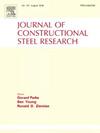Research on lateral load-resisting performance of cruciform cold-formed steel built-up columns
IF 4
2区 工程技术
Q1 CONSTRUCTION & BUILDING TECHNOLOGY
引用次数: 0
Abstract
This paper proposes a cold-formed thin-walled steel (CFS) frame structure with fully bolted connections, which can solve the challenges associated with beam-column joints that cannot be connected. It takes into account the issues of discontinuous vertical load transfer and the insufficient horizontal load resistance capacity of traditional “box” structure. To grasp the lateral load-resisting performance of the cruciform CFS built-up columns in the above structure, the cross-sectional dimensions and effective lengths will be considered as parameters. Experimental tests were carried out on six built-up columns to investigate the failure modes and lateral load-resisting performance under cyclic reversed loading tests at first. Secondly, a nonlinear finite element model of such built-up columns was established based on ABAQUS software, and validated against experimental results. The influence of axial compression ratio, web height to plate thickness ratio, and overall slenderness ratio were analyzed so as to further understand the influence of main parameters on the lateral load-resisting performance. Finally, the stiffness degradation characteristics in lateral load-resisting were proposed. The research results indicated that the built-up column experienced complete loading process, resulting in plastic cracks that occurred global flexural failure due to severe buckling deformation at the bottom flange-web joint of the column limb. Meanwhile, it shows good ductility, deformation, and energy dissipation ability. Regarding the specimens with the same effective length, when the height of the web increased from 105 mm to 135 mm and then to 195 mm, the ultimate capacity of the specimens increased by at least 49.48 % and 110.15 %, respectively. However, when the effective length was reduced from 1950 mm to 1250 mm, the ultimate capacity of the specimen increased by at least 39.35 %, despite the same cross-sectional dimension. Therefore, compared to the effective length, the cross-sectional dimension has a significant influence on the lateral bearing capacity. Additionally, compared with axial compression ratio, the web height to plate thickness ratio and overall slenderness ratio had significant influence on the lateral bearing capacity and initial stiffness.
求助全文
约1分钟内获得全文
求助全文
来源期刊

Journal of Constructional Steel Research
工程技术-工程:土木
CiteScore
7.90
自引率
19.50%
发文量
550
审稿时长
46 days
期刊介绍:
The Journal of Constructional Steel Research provides an international forum for the presentation and discussion of the latest developments in structural steel research and their applications. It is aimed not only at researchers but also at those likely to be most affected by research results, i.e. designers and fabricators. Original papers of a high standard dealing with all aspects of steel research including theoretical and experimental research on elements, assemblages, connection and material properties are considered for publication.
 求助内容:
求助内容: 应助结果提醒方式:
应助结果提醒方式:


